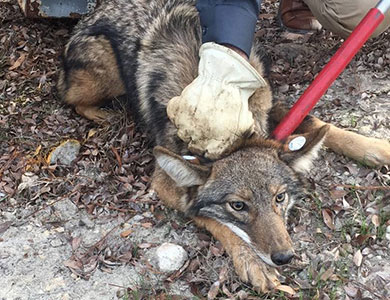Coyote Harvest Incentive Program
 The Coyote Harvest Incentive Program was created in 2016 by a Legislative Budget Provision (47.10), which directed SCDNR to develop and implement a coyote tagging and reward program. Annually, SCDNR traps, tags and releases four coyotes per game zone (16 total). Beginning in July of 2023, the budget proviso was modified to change the reward from a free lifetime hunting license to a $3,000 reward per tagged coyote taken after this date. Anyone who successfully takes and reports a specially tagged coyote will be rewarded with $3,000. The person reporting the tagged coyote has the option to designate anyone for the monetary reward such as a child, relative, or friend. No hunter/trapper, or their designee, may collect the $3,000 reward on more than two coyotes per fiscal year. Employees of the Department of Natural Resources, members of the General Assembly, and their immediate families are not eligible to receive this reward.
The Coyote Harvest Incentive Program was created in 2016 by a Legislative Budget Provision (47.10), which directed SCDNR to develop and implement a coyote tagging and reward program. Annually, SCDNR traps, tags and releases four coyotes per game zone (16 total). Beginning in July of 2023, the budget proviso was modified to change the reward from a free lifetime hunting license to a $3,000 reward per tagged coyote taken after this date. Anyone who successfully takes and reports a specially tagged coyote will be rewarded with $3,000. The person reporting the tagged coyote has the option to designate anyone for the monetary reward such as a child, relative, or friend. No hunter/trapper, or their designee, may collect the $3,000 reward on more than two coyotes per fiscal year. Employees of the Department of Natural Resources, members of the General Assembly, and their immediate families are not eligible to receive this reward.
Over the last seven years, a total of 144 coyotes have been tagged and released, including the 16 coyotes tagged this last trapping season. To date, just less than half of the tagged coyotes have been reported taken. Coyotes tagged in any year are eligible for the reward incentive. The specially marked tags provide contact information directly on them. Only the uniquely identifiable SCDNR coyote tags are eligible for this reward as there are potentially some coyotes that have been tagged for research purposes.
| Year | Reported Trapped |
Estimated Shot from Hunters' Survey |
Reported Predator Management Permits |
Reported Night Hunting |
Total Harvest Estimate |
|---|---|---|---|---|---|
| 2005 | 1,039 |
20,159 |
21,198 |
||
| 2006 | 1,112 |
20,194 |
21,306 |
||
| 2007 | 1,223 |
23,957 |
25,180 |
||
| 2008 | 1,520 |
25,526 |
27,046 |
||
| 2009 | 2,384 |
29,783 |
32,167 |
||
| 2010 | 2,123 |
30,800 |
32,923 |
||
| 2011 | 2,205 |
32,204 |
34,409 |
||
| 2012 | 2,584 |
28,211 |
343 | 31,138 |
|
| 2013 | 2,595 |
30,076 |
111 | 32,782 |
|
| 2014 | 2,500 |
31,306 |
250 | 34,056 |
|
| 2015 | 2,751 |
29,027 |
150 | 31,928 |
|
| 2016 | 2,429 |
28,513 |
481 | 31,423 |
|
| 2017 | 2,159 |
22,441 |
736 | 180 | 25,516 |
| 2018 | 2,619 | 22,731 | 590 | 267 | 26,207 |
| 2019 | 2,618 | 20,674 | 501 | 1,953 | 25,746 |
| 2020 | 3,448 | 18,919 | 142 | 2,308 | 24,817 |
| 2021 | 2,612 | 16,298 | 274 | 1,438 | 20,348 |
| 2022 | 2,243 | 21,750 | 257 | 1,618 | 25,856 |
| 2023 | 1,697 | 21,761 | 164 | 3,844 | 27,466 |
| 2024 | 2,471 | 24,142 | 193 | 2,515 | 29,321 |
